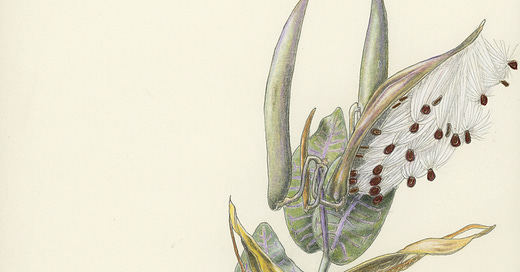When you spend as much time out in the woods as I do, you mark the seasons with what nature is doing rather than with a calendar. And in a way, nature marks the seasons more precisely and meaningfully than any Gregorian, Julian, Mayan or Aztec calendar. Although all these calendars intend to predict, their predictions are not precise, so that from one year to another, the first sprays of white, wild plum blossoms do not appear on the same calendar date, no matter what your calendar of choice, nor does the drunken purple scent of wisteria fill the air, nor the pale green spirals of bracken unfurl or the thin celodon spears of wiregrass protrude.
When the last pitcher plants have dropped their maroon petals, the pods of the pinewoods milkweed burst to release their parachuting seeds and the fuzzy purple spikes of lady lupine have gone to seed, I know that spring has come to an end.
For me, it is not the withering, humid heat that marks the arrival of summer, but the simultaneous appearance of orange in the persona of orange milkweed (butterfly weed) and yellow in two species of composites (sunflower family) called, oddly, greeneyes. Neither flower picks well, sometimes wilting in minutes, but I am never without a container of water in my car so I can bring the vase to the flower and get the flower into water mere seconds after I cut it. Why all this trouble? Why not pick flowers that don't wilt so fast? Perhaps it is my visual cortex on drugs, or perhaps a short-circuit in my retina, but to me, orange mingled with yellow, underpinned by green produces a kind of delicious vibration, a play and counter-play that commands and pleasures my attention. It is the visual equivalent of a beautiful chord of music, a visual harmonic that enriches color, much as a musical harmonic enriches sound. I don't know if others experience the orange-yellow combination as I do, and perhaps it is some peculiar neural structure of mine, but it has always been thus.
But summer passes, unmourned by most as the withering heat begins to fade, but just as summer's arrival is marked by orange and yellow flowers, fall's is marked by violet and yellow. The sandhills and flatwoods prickle with the violet spears of blazing star, the flat purple heads of ironweed, and roadsides are awash in dense yellow stands of goldenrod (all composites). Just as the harmonics of orange and yellow sound an energetic, ecstatic, erotic chord, so the yellow and violet of fall sound a more somber, deeper note. The somberness is compensated by the sheer abundance of the bloom, a final effort of the year, and I assemble thick bouquets that take up serious space as a farewell to the seasons I love and the colors that mark them.
A Post-script:
In the decade or two since I first wrote this piece, most of the glorious goldenrods that made our region’s roadsides such a joy in the fall have vanished in overwhelming masses of giant ragweed. It is not clear why this happened, but it feels like a deep loss. Giant ragweed is a rag-tag plant with little appeal, although the scale of its success is certainly impressive. In the fall, its thousands of tiny wind-pollinated flowers create vast suffering among allergic humans every year. It is a sad replacement for goldenrod.






I too have mourned the explosion of tick weed or rag weed that has taken over yards and roadsides. In 1988 when I moved to Jefferson County east of Tallahassee the roads were lined with wildflowers including beautiful red clover. Now it’s a clutter of ugly ubiquitous white tick weed. Where’s the legacy of Lady Bird Johnson, who beautified our country?
I missed this wonderful essay in the flood of my subscriptions but it is remarkable how color and music are woven together in an almost synaesthetic whole. I'm incapable of such perception.. my lack, alas.